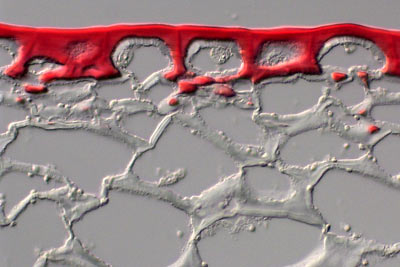Researchers identify how plant skins are stitched together
By Krishna Ramanujan

For the first time, scientists have identified how a plant's skin is assembled.
All plants have a skin, called a cuticle, that covers the above-ground surfaces. It is composed of waxes and a polymer network -- a large molecule made of fatty acid building blocks called cutin that are bonded together.
The findings, published online May 21 and to appear in the July issue of Nature Chemical Biology, have important agricultural implications, since understanding the basic biology of plant skins opens the door for researchers to develop therapies to prevent plant diseases and other cuticle-related conditions in the future.
Plant skins are essential to prevent leaves, stems, flowers and fruits from drying out, provide a barrier against pathogens, protect against ultraviolet radiation and prevent organs from fusing together during development. The waxy coating is also responsible for the "lotus effect" that causes water to bead off a plant's surface, taking dust and microbial spores with it.
"How these building blocks of cutin get put together has been completely unknown," said Jocelyn Rose, associate professor of plant biology and the paper's senior author. Trevor Yeats and Laetitia Martin, graduate students in Rose's lab, are the lead authors.
With respect to a plant's cuticle, "we identified the immediate building blocks of tomato cutin and the sites and mechanism of their assembly," Rose said.
To do so, the researchers examined mutant tomatoes that had very thin skins and dried out easily compared with wild-type tomatoes.
While single building blocks (monomers) of cutin were found in the mutant, there was little of the cutin polymer in the skin. The researchers isolated an enzyme called CD1 in the skin of healthy tomatoes that is responsible for knitting single units of cutin into a polymer. But in the mutant tomato, no CD1 enzyme was detected, likely due to a mutation in the gene that encodes CD1.
In normal tomatoes, however, the researchers discovered that cutin monomers are secreted at the edge of a polysaccharide layer found on the inner side of the plant skin. The cutin monomers then travel across the polysaccharide layer where they are stitched together into polymers with the help of the CD1 enzyme near the surface of the skin.
Identifying the utility of the CD1 enzyme in building the cutin polymer "was the last link in the chain for this critical structure," Rose said.
Furthermore, the researchers found gene sequences that are closely related to the tomato CD1 gene across the entire land plant kingdom, including mosses, which are close relatives of some of the first land plants. But CD1-like genes were not found in algae, aquatic plants that have no need for a skin that prevents desiccation.
The findings suggest that the evolution of enzymes similar to CD1 paved the way for the waxy cuticle and enabled colonization of land by plants more than 400 million years ago.
As the plant's cuticle is a dynamic structure that is modified by the environment, future research will focus on better understanding how the CD1 enzyme is regulated and how plants adapt to changing conditions.
"Now we can understand the entire life span of the cuticle," Rose said.
Co-authors include researchers at the Newe Ya'ar Research Center in Israel, Technical University of Denmark, Shanghai Jiao Tong University in China and Skidmore College.
The study was funded by the National Science Foundation, U.S.-Israel Binational Agricultural Research and Development Fund, U.S. Department of Agriculture, Danish Council for Strategic Research and National Institutes of Health.
Media Contact
Get Cornell news delivered right to your inbox.
Subscribe